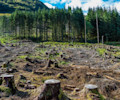Updated on 07 March 2025 to reflect developments from the resumed COP16 sessions held in Rome from 25 - 27 February 2025.
Introduction
The global food system is the leading driver of biodiversity loss and deforestation, with livestock contributing to 14.5% of global greenhouse gas emissions. The UN Biodiversity Conference in Cali, Colombia (COP16) represented a pivotal moment to address this, with significant implications for the agri-food sector and the investment community.
Anecdotal evidence suggests the participation of financial institutions has grown markedly since COP15, driven by this year’s emphasis on implementation and finance. Investors increasingly recognise biodiversity loss as a material systemic risk, and as a result, are using their voice to encourage policy action in support of the Kunming-Montreal Global Biodiversity Framework (GBF).
This Insight piece outlines some of the key takeaways from the discussions that dominated the food and finance events at COP16 in October 2024 and at COP16.5 in February 2025, with a focus on GBF targets 15, 18 and 19, which address risk disclosure, harmful incentives, and resource mobilisation for nature.
Key takeaways for investors
Implementing the GBF through national action plans
The investment community voiced its need for an enabling policy environment. Here, National Biodiversity Strategies and Action Plans (NBSAPs) play a crucial role, as these are expected to shape national policies and taxonomies for tackling biodiversity loss at a country level, directly affecting investors and investees.
Countries were required to align their NBSAPs with the GBF, yet as of February 2025, three-quarters of countries are yet to publish their NBSAP plans, including the world’s most biodiverse nation, Brazil, and COP17 host Armenia.
The translation of the GBF into practical policies tailored to specific countries will need to happen to clearly show the private sector that there is global ambition to manage nature loss, as the current misalignment fails to create the enabling policy environment that investors seek.
The Agri-NBSAPs Support Initiative, launched by the FAO and the Convention on Biological Diversity (CBD) Secretariat during COP16, should help countries to update their NBSAPs.
Investors reiterated their ask for governments to repurpose harmful subsidies that contribute to biodiversity loss, particularly in agriculture, and called for a whole-government approach that coherently integrates nature and biodiversity into economic policy.
A key topic of discussion was Target 18, focusing on harmful subsidy reform, which as outlined in an investor statement, is crucial for restoring biodiversity and improving sustainability in agriculture.
However, many at the conference acknowledged the importance of understanding potential trade-offs, compounded by the challenge of having insufficient information. Given the complexities, only six countries had made substantive references to this issue in their NBSAPs.
Nature-related disclosures rapidly adopted
As companies and investors increasingly recognise nature as a material risk and opportunity, voluntary nature-related disclosures are gaining traction. However, a critical challenge remains: investors often lack reliable, actionable data from investees on biodiversity impacts.
COP16 featured significant discussions around the Taskforce on Nature-related Financial Disclosures (TNFD), a promising solution to bridge this gap. Notably, over 500 companies, representing US$6.5 trillion in market capitalisation (including 129 financial institutions with US$17.7 trillion in AUM), committed to TNFD-aligned reporting.
TNFD disclosures also encompass lobbying activities, and investors emphasised the importance of corporates aligning their climate and nature commitments and lobbying efforts, whether through direct advocacy or industry associations.
These voluntary disclosures are expected to become mandatory eventually, as Target 15 states that governments have agreed to adopt policy measures encouraging corporates to regularly monitor and disclose their biodiversity impacts.
Investors play a critical role in ensuring Target 15 is implemented, by engaging companies to assess and disclose how their operations depend on and impact nature, which is especially acute for the food and agriculture sector.
Yet, disclosure alone is not enough – credible transition plans are essential.
Resource mobilisation to catalyse private finance
Under Target 19, COP16 aimed to establish a funding strategy, including incentives to close the finance gap and ensure public and private capital markets work together in support of the Sustainable Development Goals by 2030.
The World Bank pledged to double its agricultural financing commitments to US$9 billion annually by 2030, which represents a significant step toward securing long-term investment in sustainable agriculture and biodiversity.
Conversations in Cali highlighted that mobilising capital from developed to developing markets needs to prioritise adaptation and resilience, alongside mitigation and nature-based solutions. These areas present significant investment opportunities, especially as the frequency of extreme weather events increases, driving demand for recovery solutions and early warning systems.
Throughout the conference, there was a shared understanding that climate and nature are two sides of the same coin, while the concept of 'stacking' was frequently discussed. This refers to using measures that support nature and climate – such as carbon mitigation measures that also support biodiversity – and combining several financial incentives, from blended finance to insurance, to deliver positive outcomes.
Encouragingly, COP16’s Finance Day saw US$163 million pledged to the GBF Fund. However, more than triple this level of capital deployment is needed to achieve the GBF targets, with the funding gap for biodiversity conservation estimated to be around US$700 billion per year.
An overall agreement on funding mobilisation wasn’t reached in Cali in October 2024, but governments and financial institutions have since committed to:
increase biodiversity-related international financial flows to developing countries, targeting at least US$20 billion per year by 2025 and US$30 billion per year by 2030;
mobilise at least US$200 billion annually by 2030 from domestic, international, public, and private sources to scale up positive incentives for biodiversity conservation and sustainable use; and
phase out or reform subsidies harmful to biodiversity by at least US$500 billion per year by 2030 (GBF Target 18).
Monitoring progress until the stocktake at COP17 in Armenia in 2026
The COP16 conference aimed to establish a realistic monitoring framework, which includes agreeing on mandatory and optional indicators for each of the 23 targets. Monitoring GBF implementation is essential for government accountability, resource mobilisation, and to demonstrate the enabling policy environment that investors need to catalyse action. However, no conclusion was reached, as this was dependent on the resource mobilisation outcome.
Pricing nature and biodiversity to close the funding gap
While half of global GDP depends on nature, and institutional portfolios rely on biodiversity to generate value, the risks of biodiversity loss are not priced into economic models. This presents a challenge for investors wanting to allocate capital to nature-positive solutions.
Some attendees argued that 100% of GDP ultimately depends on nature's functions and urged companies to integrate natural assets and ecosystem services into their balance sheets.
One potential solution proposed in Target 13 and discussed at COP16 was sharing the benefits that nature provides to business through Digital Sequence Information (DSI) – finding a way to value ecosystem services and equitably share profits with nature stewards, such as Indigenous peoples and local communities in developing regions.
Negotiators agreed on a levy of 1% of profits, or 0.1% of revenue for large DSI users—targeting sectors like agriculture, pharmaceuticals, and cosmetics—that could raise about US$1 billion annually for biodiversity conservation, named the Cali Fund.
Next steps: Integrating nature and climate at COP29 and COP30
Discussions at COP16 underscore that the world has made some progress in implementing the Kunming-Montreal Global Biodiversity Framework and that investors are increasingly relevant in such discussions.
The true challenge lies in sustaining this momentum through to the next biodiversity COP, particularly by forging stronger connections between nature and climate action.
As attention shifts to Climate COP30 in Brazil this November, bringing us back to Latin America— this time closer to the biodiversity hotspot of the Amazon.
FAIRR will continue to participate in these opportunities by raising awareness of the food and agriculture risks and opportunities, and convene investors, policymakers and other stakeholders in dialogues to ensure a sustainable and just transition of this environmentally impactful yet nature-dependent sector.
FAIRR insights are written by FAIRR team members and occasionally co-authored with guest contributors. The authors write in their individual capacity and do not necessarily represent the FAIRR view.











